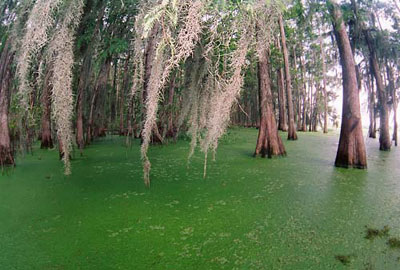Spanish Moss
Tillandsia usneoides
Family: Bromeliaceae
Natural History

Spanish moss hanging from bald cypress branches
Photo credit: SFRC, University of Florida
Spanish moss, also called Florida moss, long moss, or graybeard, is not a true moss. It is an epiphytic plant, which grows on another plant, but does not rely on the host plant for nutrients; epiphytes make their own food.
They are sometimes referred to as air plants because most have aerial roots; however, Spanish moss does not have any roots. It uses its long, thin, scaly stems to wrap around the host tree and hang down from the branches. The leaves are covered with cup-like, permeable scales that 'catch' moisture and nutrients from the air and from pockets on the surface of the host. This water-trapping ability allows Spanish moss to withstand long dry periods. In extreme dry spells, the plant becomes dormant until moisture returns.
While the plant is not parasitic, it can sometimes damage the host tree by over-shading the leaves, thus reducing photosynthesis, or by weighing down and breaking the branches.
The plants have very tiny seeds that are dispersed by wind and birds. Birds may also carry off small fragments that easily reproduce new plants. Spanish moss was harvested for years as a stuffing material in automobile seats, furniture, and mattresses. The moss-stuffed mattresses were said to be cooler and more comfortable due to the natural insulating properties of the plant. This was especially important in pre-air-conditioning days. Moss pickers were hired and used long poles to pull the stringy masses off the trees. The plants were then dried and cured before being used.
Today, the stems are used occasionally in upholstery and as a packing material. Spanish moss is a popular mulch and is widely used in the floral industry. Many floral arrangements use Spanish moss around the plant base to hold in moisture. It is also seen in certain types of Cajun architecture as insulation and it is sometimes draped along fences or wires to provide privacy screening in backyards.
Several species of songbirds use the plant material for nest building or weave their nests in the moss clumps. Warblers are especially fond of these sites, as are bats. Many reptiles and amphibians hide inside the thick masses. Redbugs, or chiggers, are also common residents in Spanish moss on the ground and may cause an unpleasant, itching rash on the skin if the plants are handled.
Spanish moss is limited to Central and South America and the southeastern United States, from Florida to Texas.

